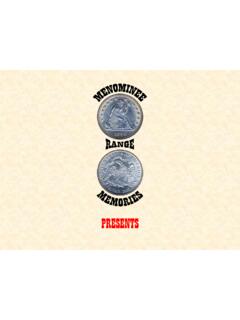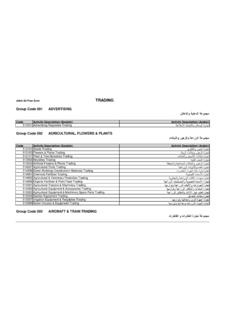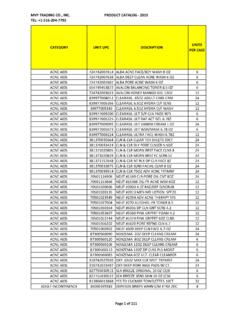Transcription of MENOMINEE RANGE MEMORIES 6: EARLY …
1 MENOMINEE RANGE MEMORIES 6: EARLY trading . POSTS AND HALF-WAY HOUSES FROM MENOMINEE . NORTH. By William J. Cummings, MENOMINEE RANGE Historical Foundation Historian Several EARLY trading posts and stopping places are indicated on this map, including (3). Chappee Rapids, (7) Kitson's [John G. Kittson], (8) De Coto's [Joseph De Coto] and (10). Battise's [possibly Baptiste Premeau]. This map, published in Michigan History, Volume 47, Number 4 (December, 1963), accompanied an article containing excerpts from Alanson Forman Lyon's diary entitled A Trip Up the MENOMINEE River in 1854.
2 [Michigan History]. 1. MENOMINEE RANGE MEMORIES 6: EARLY trading . POSTS AND HALF-WAY HOUSES FROM MENOMINEE . NORTH. By William J. Cummings, MENOMINEE RANGE Historical Foundation Historian trading posts were the first vestiges of to a home with civilization, and his post civilization in the frontier area of the Upper sometimes presented the appearance of a Peninsula and northeastern Wisconsin. well garrisoned fort, and at other times he The MENOMINEE River was the principal was left almost solitary and alone to defend waterway and route to follow northward it if hostile Indians approached.
3 From Lake Michigan. His post was solidly built of logs with In the Centennial History of MENOMINEE palisades made of heavy timbers set in the County by the Hon. Eleazer Stillman ground around it.. Ingalls, published in 1876, mention is made Chappee built his first trading post on of a number of individuals who traded with the Wisconsin side of the MENOMINEE the Indians along the MENOMINEE River. River, carrying on his trade with the Indians Louis Chappieu/Chappee for many years, until dispossessed by trading Post at Chappee's Rapids on William Farnsworth and Charles Brush, who the MENOMINEE River wanted the site for a sawmill.
4 According to Ingalls, The first white After being dispossessed of his man who came to MENOMINEE to stay was property, Chappee crossed the MENOMINEE Chappee [Louis Chappieu or Chappee, an River and built a new trading post near the Indian trader and French Canadian foot of Chappee's Rapids which were voyageur], who came here [ MENOMINEE ] as named after him about five miles up the an agent for the [British-] American Fur river from the village of MENOMINEE . He Company and established a [ trading ] post surrounded this post with palisades in the in 1796 [on the Wisconsin side of the same manner as he did the first one, and MENOMINEE River].
5 Remained there trading with the Indians until At that time many thousand Indians he died in 1852. visited the MENOMINEE river every season, According to Ingalls, Chappee took to while at the north and about the himself a squaw, with whom he lived, and headquarters of the river, and towards Lake raised children, as was the custom with the Superior, the Chippewas had numerous traders in those days, but to whom he was villages which were accessible by birch never married.. canoes. There was an abundance of The first recorded inhabitants of the beaver, otter, mink, muskrat, martin and MENOMINEE River Basin were a small fishers, bear, deer, and less valuable game, Algonquin tribe known as the wild rice throughout the country, and this post people.
6 Journals of seventeenth and EARLY became an important trading point. eighteenth century explorers describe a Chappee was a French-Canadian tribe of forty to eighty men living in a single voyageur, with sufficient education to keep village at the mouth of the MENOMINEE what books were necessary for an Indian River. By the EARLY 1820's, the MENOMINEE trading post, and was apparently the right numbered about 500 men, and were man for the place. He was stirring and scattered throughout a dozen villages in active, and had sufficient courage and Wisconsin. Between 1670 and the EARLY nerve for any emergency that might arise.
7 1800's, various explorers, fur traders and He had a large number of men, picked up missionaries visited the area as they from that class of Canadian voyageurs who passed by on the water routes of Green preferred a life in the solitude of the forests Bay and the MENOMINEE River. 2. MENOMINEE RANGE MEMORIES 6: EARLY trading . POSTS AND HALF-WAY HOUSES FROM MENOMINEE . NORTH. By William J. Cummings, MENOMINEE RANGE Historical Foundation Historian The first known white settler on the Jacobs went to Canada on a trading trip MENOMINEE River was Stanislaus Louis and never returned.
8 Marie married Chappieu, Chappu, or Chappee, a French- Farnsworth. They were the parents of two Canadian fur trader who operated a log sons and a daughter. trading post at the site of Marinette, By 1831 Farnsworth left the area to Wisconsin, between 1794 and 1824. settle in Sheboygan, Wisconsin. Marie Chappee, born in 1766 in Canada, remained and developed the trading post established a trading post on the Wisconsin into a large trading center. An influential side of the mouth of the MENOMINEE River M tis woman, she was known for her in about 1794. [Later the MENOMINEE River business sense, fairness and influence in Manufacturing Company office, opposite the region, having ties to both the Queen Marinette's house, occupied this MENOMINEE Indian and European site.]
9 ] Chappee traded with the Indians for communities. [The M tis people are furs for many years, eventually becoming Indigenous North Americans of mixed race. an agent for John Jacob Astor's American M tis are recognized by the government of Fur Company. Canada as one of the official Aboriginal In about 1822 another fur trader, William peoples.] She came to be known as Farnsworth, arrived at the mouth of the Queen Marinette.. MENOMINEE River. The following year John After her death in 1865, Queen Jacobs, also a fur trader, moved to the area Marinette was buried in Allouez. In 1987.
10 With his wife, Marie Antoinette Chevalier. her descendants had her reinterred in a Marie, born in 1793 at Post Lake, sarcophagus at the Forest Home Langlade County, Wisconsin, was the Mausoleum in Marinette. Her original daughter of Bertrand Chevalier, a British tombstone is on display at the museum on trader of French Canadian ancestry, who Stephenson Island in Marinette. was involved with an EARLY trading post in Within a few years of Farnsworth's Green Bay, Wisconsin. Her mother was arrival at the mouth of the MENOMINEE Lucy, the daughter of a MENOMINEE chief River, he had usurped Chappee's position named Wauba-Shish (Great Marten).










